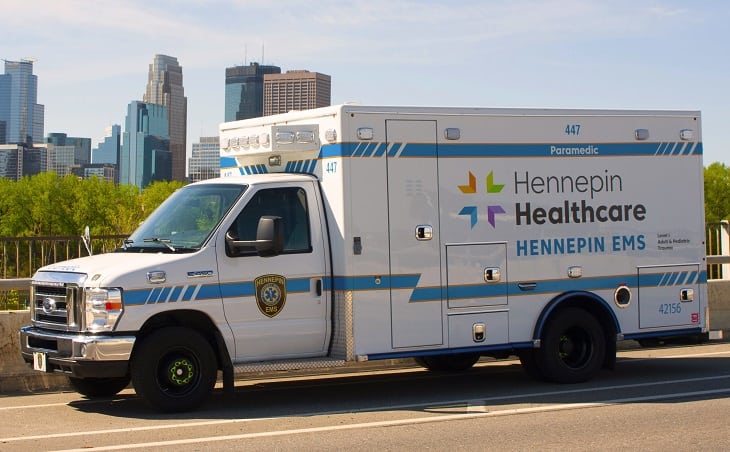Hennepin EMS pilots app that connects to an interpreter with the push of a button

When you’re experiencing an emergency, it’s a relief when help arrives. But what do you do when that help doesn’t speak the same language as you? This scenario is why Hennepin EMS has been piloting a new translation app called Jeenie that connects first responders to a live interpreter within seconds.
When paramedics respond to a medical emergency, language barriers can often add complications to an already stressful situation. EMS team members would have to rely on family members or others on the scene to translate, but sometimes there wasn’t anyone that spoke English. Although Hennepin EMS had access to interpreters, connecting on the phone could take up precious time – often time they didn’t have.
“Historically, if there was a non-English speaking patient, we’ve brought them to the hospital and shared vital signs or a physical exam, but we haven’t been able to have a robust conversation. Jeenie allows us to include that missing context,” says Nick Simpson, MD, Chief Medical Director of Hennepin EMS. “The thing that makes this tool so important for us is that it really is one button, and you instantly get an interpreter.”
When Hennepin EMS began its search for a translation tool, they met with the experts – our Interpreter Services department.
“We shared with them that we really needed something that’s one button, since we realistically don’t have time to go through phone trees or collect upfront data. Frequently these situations are dynamic and just don’t allow that kind of time,” says Nick. “With looking at all the things that Interpreter Services offered at the time, this unfortunately wasn’t something they could do in the way we needed.”
When researching other options, it was also important that this new tool met security encryption requirements, was HIPAA compliant, and had certified healthcare interpreters – Jeenie checked off those boxes.
After a successful pilot with EMS physicians and community paramedics, Interpreter Services was instrumental in ensuring EMS team members knew how to use and were comfortable using Jeenie. During a simulated medical emergency, Hennepin Healthcare interpreters acted as non-English speaking patients while paramedics practiced using Jeenie to communicate. Afterwards, Interpreter Services offered vital feedback and advice to ensure responders could make the most of the virtual translation platform.
Now all Hennepin EMS ambulances are equipped with iPads with Jeenie already installed – dispatch workstations also have the app available. When a paramedic needs an interpreter, they simply open the app, select the language, choose audio or video, and within a few seconds they are speaking with an interpreter.
“It’s been a real game changer in a number of situations that we’ve been a part of,” says Nick. “During one encounter, there was an ASL patient who had clearly been used to scribbling on paper or typing in their phone back and forth to communicate. After being able to bring up an ASL video interpreter, you could see the patient’s relaxation in their physical posture and then it was a much more efficient discussion of what was actually happening.”
In another instance, Hennepin EMS responded to a car accident where the entire family spoke Spanish. Although the family members didn’t show any signs of significant injury, with Jeenie, paramedics were able to ask about their symptoms rather than just relying on a physical assessment.
“I think implementing this app has been a big step towards health equity,” says Nick. “If I speak Somali, my level of care shouldn’t be any different than a native English speaker.”
Since implementing the app a year and a half ago, Hennepin EMS has accessed interpreters in 33 different languages out of the 300 offered by Jeenie.
“We have utilized languages that I never would have imagined, probably just because we haven’t been able to start that conversation. There are languages that I haven’t used in the ED but we’ve used prehospital, which I think is super cool. It’s really changed the dynamic with the patient, and that’s been a very positive thing.”

